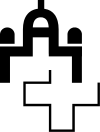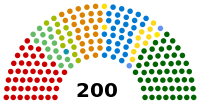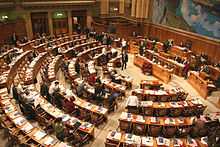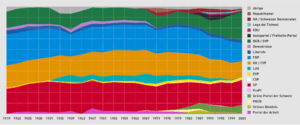National Council (Switzerland)
| National Council German: Nationalrat French: Conseil National Italian: Consiglio Nazionale Romansh: Cussegl Naziunal | |
|---|---|
 | |
| Type | |
| Type | Lower house |
| Leadership | |
| President |
Ruedi Lustenberger, CVP/PDC Since 25 November 2013 |
| First Vice President |
Stéphane Rossini, SPS/PSS Since 25 November 2013 |
| First Vice President councillor |
Christa Markwalder, FDP/PLR Since 25 November 2013 |
| Structure | |
| Seats | 200 |
 | |
| Political groups | |
| Elections | |
| Voting system |
Party-list proportional representation Hagenbach-Bischoff system |
| Last election | 23 October 2011 |
| Meeting place | |
 | |
| Federal Palace of Switzerland, Bern | |
| Website | |
| http://www.parliament.ch/ | |
The National Council (German: Nationalrat, French: Conseil National, Italian: Consiglio Nazionale, Romansh: Cussegl Naziunal) is the lower house of the Federal Assembly of Switzerland. With 200 seats, it is the larger of the two houses.
Members are elected by adult citizens, along with the Swiss Council of States. 4.6 million citizens were eligible to vote in 2003. The members, called 'National Councillors', serve four-year terms.
Proportional voting
Each of Switzerland's 26 cantons is a constituency. The number of deputies for each constituency depends on the canton's population, but each canton has at least one deputy.
Each citizen can vote for as many candidates as there are deputies in the canton. A voter cannot give more than two votes to the same candidate. Each voter can choose candidates of multiple parties.
Fictional voter
To determine a party's strength, the notion of "fictional voter" was introduced and is defined by the Swiss Federal Statistical Institute as: number of votes obtained by party A * (number of valid ballots / number of valid votes). Individual voters can choose to make fewer than the permissible number of votes. The number of valid votes / number of valid ballots closely match the number of deputies a canton needs to elect. More exactly, this number represents the average number of valid votes per voter. The formula can then be summed up by: number of votes obtained by party A / average of valid votes per voters.
The result is the number of fictional voters for a given party in a given canton. A total number of fictional voters can then be established and the party strength can be deduced.
The number of deputies in each party is determined at the cantonal level using proportional representation with the Hagenbach-Bischoff system (except in single-member cantons.) The election's turnout is computed as: number of valid ballots cast / number of registered voters.
2011 election
.svg.png) |
| This article is part of a series on the politics and government of Switzerland |
|
Federal Assembly
|
|
Subdivisions
|
|
The National Council election in 2011 resulted in the strengthening of the political center and the reversing of the trend towards polarisation in Swiss politics that took place during the 1990s and 2000s. During this election, centrist parties gained about 7% of the popular vote, with the right pole losing 3.6% and the left pole losing 3.5%. Voter turnout was 48.5%, compared to 48.3% in 2007.
| Parties | Abbr. | Alignment | Ideology | Votes[1] | % | +/– | Seats | +/– | |
|---|---|---|---|---|---|---|---|---|---|
| Swiss People's Party | SVP/UDC | Right-wing | Conservatism | 648,675 | 26.6 | −2.3 | 54 | −8 | |
| Social Democratic Party | SPS/PSS | Centre-left | Social democracy | 457,317 | 18.7 | −0.8 | 46 | +3 | |
| FDP.The Liberals | FDP/PLR | Centre-right | Classical liberalism | 368,951 | 15.1 | −2.5 | 30 | −5 | |
| Christian Democratic People's Party | CVP/PDC | Centre | Christian democracy | 300,544 | 12.3 | −2.2 | 28 | −3 | |
| Green Party | GPS/PES | Centre-left | Green politics | 205,984 | 8.4 | −1.2 | 15 | −5 | |
| Conservative Democratic Party | BDP/PBD | Centre-right | Conservatism / economic liberalism | 132,279 | 5.4 | New | 9 | New | |
| Green Liberal Party | GLP/PVL | Centre | Green liberalism | 131,436 | 5.4 | +4.0 | 12 | +9 | |
| Evangelical People's Party | EVP/PEV | Centre | Christian democracy | 48,789 | 2.0 | −0.4 | 2 | ±0 | |
| Federal Democratic Union | EDU/UDF | Right-wing | Christian right | 31,056 | 1.3 | ±0 | 0 | −1 | |
| Alternative Left (Party of Labour, solidaritéS) | LIN/GAU | Left-wing | Socialism / communism | 21,482 | 0.9 | −0.2 | 0 | −1 | |
| Ticino League | LdT | Right-wing | Regionalism / Right-wing populism | 19,657 | 0.8 | +0.3 | 2 | +1 | |
| Geneva Citizens' Movement | MCG | Right-wing | Regionalism / Right-wing populism | 10,714 | 0.4 | +0.3 | 1 | +1 | |
| Christian Social Party | CSP/PCS | Centre-left | Christian left | 6,248 | 0.3 | -0.2 | 1 | ±0 | |
| Other | 54,622 | 2.2 | |||||||
| Total (turnout 48.5%) | 2,442,648 | — | — | 200 | — | ||||
| Source: Swiss Federal Statistical Office (French) | |||||||||
Committees
- Foreign Affairs Committee (FAC)
- Committee for Science, Education and Culture (CSEC)
- Committee for Social Security and Health (CSSH)
- Committee for the Environment, Spatial Planning and Energy (CESPE)
- Defence Committee (DefC)
- Committee for Transportation and Telecommunications (CTT)
- Committee for Economic Affairs and Taxation (CEAT)
- Political Institutions Committees (PIC)
- Committee for Legal Affairs (CLA)
- Committee for Public Buildings (CPB)
Supervisory committees
- Finance Committee (FC)
- Control Committees (CC)
- Parliamentary investigation committees (PIC)
Other committees
- Committee on Pardons
- Rehabilitation Committee
- Drafting Committee
- Judicial Committee
Members per canton

| Abbr | Canton | Number of Seats | Population (2009) | Population per seat |
|---|---|---|---|---|
| ZH | 34 | 1,406,083 | 41,355 | |
| BE | 26 | 985,046 | 37,886 | |
| LU | 10 | 381,966 | 38,197 | |
| UR | 1 | 35,382 | 35,382 | |
| SZ | 4 | 147,904 | 36,976 | |
| OW | 1 | 35,878 | 35,878 | |
| NW | 1 | 41,311 | 41,311 | |
| GL | 1 | 39,217 | 39,217 | |
| ZG | 3 | 113,597 | 37,866 | |
| FR | 7 | 284,668 | 40,667 | |
| SO | 7 | 259,836 | 37,119 | |
| BS | 5 | 194,090 | 38,818 | |
| BL | 7 | 277,973 | 39,710 | |
| SH | 2 | 77,139 | 38,570 | |
| AR | 1 | 53,313 | 53,313 | |
| AI | 1 | 15,789 | 15,789 | |
| SG | 12 | 483,101 | 40,258 | |
| GR | 5 | 193,388 | 38,678 | |
| AG | 15 | 624,681 | 41,645 | |
| TG | 6 | 254,528 | 42,421 | |
| TI | 8 | 336,943 | 42,118 | |
| VD | 18 | 725,944 | 40,330 | |
| VS | 7 | 317,022 | 45,289 | |
| NE | 5 | 173,183 | 34,637 | |
| GE | 11 | 472,530 | 42,957 | |
| JU | 2 | 70,542 | 35,271 |
See also
| Wikimedia Commons has media related to Federal Palace of Switzerland. |
- Presidents of the National Council of Switzerland.
- List of members of the Swiss National Council (2007-2011)
- List of members of the Swiss National Council (2003-2007)
Notes and references
- ↑ These numbers represent fictional voters. See National Council for more details.